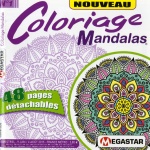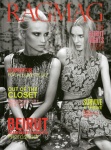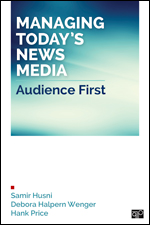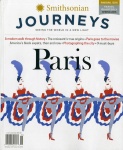HGTV & Hearst Magazines: A Success Story From Pixels On The Screen To Ink On Paper.
“I think the future is incredibly bright for print and I think that if you just look at what we’ve been doing at Hearst, which is Food Network and HGTV as partners, you can also see Esquire and Elle partnering on cross-content things. Diversity is key. We have a very diverse portfolio at this company. I think the successful print publishers are going to be the ones who are innovative, but whether it’s print, digital or TV, everything is really all about content and that’s what print does so well.” Dan Fuchs
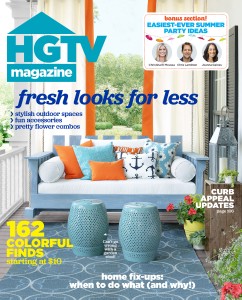 The success of HGTV Magazine has been phenomenal since the day it was launched. The magazine was inspired by HGTV’s own exciting and informative programming and brings the same helpful and trusted advice to the pages of print.
The success of HGTV Magazine has been phenomenal since the day it was launched. The magazine was inspired by HGTV’s own exciting and informative programming and brings the same helpful and trusted advice to the pages of print.
Dan Fuchs is publisher and chief revenue officer for the magazine. I spoke with Dan recently about the innovations Hearst is doing between the titles of its very successful magazines, such as the cross-content of HGTV Magazine and Food Network, Esquire and Elle, and the possibility of other dynamic combos that show true marketing and creative trailblazing. It’s an exciting time for Hearst and all of its prosperous titles.
Dan has been with Hearst for 13 years, having spent the first part of his career with the company at The Oprah Magazine and a brief stint at the now defunct Lifetime. But with HGTV Magazine, Dan is seeing a level of success that crosses boundaries between Hearst properties and brings the most important factor for Hearst and HGTV Magazine to the forefront, audience-first appreciation and consumer satisfaction.
So, I hope you enjoy the Mr. Magazine™ interview with Dan Fuchs, Publisher and Chief Revenue Officer, HGTV Magazine, as we talk about the success and popularity of a fun and exciting brand.
But first, the sound-bites:
On being approached about the publisher’s job at HGTV Magazine: I had been talking to Michael about a publisher position and he had said that there would be an interesting opportunity coming up and that I should stay tuned. And so while I was working at The Oprah Magazine, he and I had some conversations.
I had been talking to Michael about a publisher position and he had said that there would be an interesting opportunity coming up and that I should stay tuned. And so while I was working at The Oprah Magazine, he and I had some conversations.
On keeping his new appointment as publisher temporarily under wraps at first: That’s because as the publisher I am client-facing. And when you’re out there actually talking with the advertisers about their budgets that means you’re in business. And while I was fairly anxious about hitting our goals for our first issue, I think we had about 10 weeks to do it and a staff of three at that time, it was one of the most amazing experiences of my career, because to be so empowered by Michael and to have a great partner in Sara, and Jeff Hamill and his team, I just can’t say enough about the Hearst integrated media corporate team.
On why he feels HGTV Magazine and Food Network Magazine’s worked and the short-lived Lifetime didn’t: As an insider, I would say that it had a lot to do with timing. I came aboard Lifetime after the launch, so we were already a few issues into it. And the circulation hadn’t performed the way that we had expected it to. So, I don’t really know much about the time leading up to the launch; what I do know about HGTV is the way that magazine was launched was similar to the way Food Network was launched. It was very shrewd and very responsible.
On whether he felt he was taking a gamble in leaving his secure job at O, The Oprah Magazine to go the new HGTV Magazine: Did I feel like I was taking a gamble? No. I think in terms of career progression and that may be a subject for another interview, there’s a big difference between being an associate publisher and being a publisher. And were it not for having a great boss and mentor like Michael Clinton, I think it would have been much more challenging, because you really do have to rise to the occasion, particularly when you’re in a work situation where everything is being built from the ground up, meaning not only are you building strategy and weight cards, but you’re building the whole staff and you’re building the way you go to market.
On the major stumbling block he’s had to face and how he overcame it: Expectations were high because HGTV is a superbrand. And I wouldn’t call it so much of a stumbling block, but more of a challenge. Advertisers are excited about a new magazine and new ways to reach their consumers, but when you’re tied into a multimedia brand there are high expectations about how all the pieces are put together.
On the innovative methods he’s implemented at HGTV Magazine: In terms of working with Food Network; Vicki and I as you know used to work together back at Self, so we’ve got a longstanding relationship and we partner a lot because our magazines have some similarities and they’re both doing very well across consumers. They also have a great sensibility and we both work with the same great joint venture partner, so last year we did our first-ever joint cover and Sara and Maile used to work together too at, I believe, Time Inc., so they have a longstanding partnership.
On whether he believes in the future of print: I think you know the answer to that. (Laughs) I think the future is incredibly bright for print and I think that if you just look at what we’ve been doing at Hearst, which is Food Network and HGTV as partners, you can also see Esquire and Elle partnering on cross-content things. Diversity is key. We have a very diverse portfolio at this company.
On his most pleasant moment so far in his career: I’ve been privileged to have had a few of those. And reflecting back over the years, there were some pretty special moments at The Oprah Magazine, particularly as Oprah was ending The Oprah Winfrey Show after 25 years. The way the magazine was really able to communicate with readers and how special the brand was to them. I feel like magazines are a way for people to communicate with brands.
On what motivates him to get out of bed in the mornings: Well, this isn’t just HGTV Magazine specific, this is the nature of our business. What I love about this business and what makes me excited to come to work every day is every day really is different. Sure, there are production emergencies and fires to put out, but each day is an opportunity to get that feeling of wow, we accomplished something; we sold a great deal; we got a great compliment from an advertiser on an issue.
On what keeps him at night: There’s great disruption in the media business and there’s great unpredictability and I do think that it can be easy to lose your way. What are we doing on social; what are we doing with events; how are we monetizing this; how are we doing in print and e-commerce? The number of options that we’re given now, while it can be exciting, it can produce a good deal of anxiety too, because what you don’t want to ever do is lose your way.
And now the lightly edited transcript of the Mr. Magazine™ conversation with Dan Fuchs, Publisher and Chief Revenue Officer, HGTV Magazine.
Samir Husni: Can you recreate the moment when you were first approached about being publisher of HGTV magazine and how it all came about?
Dan Fuchs: I’ve been at Hearst now for 13 years and I had worked with Michael Clinton before at a previous company. Since coming over to Hearst, my experience here has really been all partnership magazines; so there was my brief stint at Lifetime, which I think, as you’ve heard David Carey talk about, we’re always launching new products and we’ve learned from all of those enterprises, and I learned a lot from that one.
I also had eight great years working underneath Jill Seelig at O,The Oprah Magazine, just a tremendous partnership and a great way to learn about how you extend what is not at first a print brand and turn it into a print execution. Also working with joint venture partners and how you take that to advertisers.
I had been talking to Michael about a publisher position and he had said that there would be an interesting opportunity coming up and that I should stay tuned. And so while I was working at The Oprah Magazine, he and I had some conversations.
Everything we do at Hearst is so very purposeful and our partnership with Scripps is really fabulous, the level of trust and sharing; both parties really benefit from the partnership. So, with Food Network being such a success and the amazing job that Vicki (Wellington) and Maile (Carpenter) had done there and the conversations that were ongoing with HGTV, but in the beginning I didn’t know for sure that it was HGTV, although I sort of figured it out as we were looking at various ad categories and some of the assignments that Michael had me doing. I’ll tell you though for a brief time I had to tell our open staff that I was working on “a special project for Michael Clinton.”
And then when I relocated offices from the Tower to The Sheffield, which is a Hearst property and where we have some of our businesses, including an amazing new office for Cosmo.com; I was sort of working there by myself in an office, but as you know I’m on the business side and Sara Peterson had been hired the year before and she had a whole team working on the editorial development of this magazine, so it was going on in the press and I was sort of stealthily going to presentations, but she didn’t know that I was going to be the publisher, nor could I tell her that.
By the time we got to the point where our test issues had come out and they were a tremendous success on newsstands, both our test issues sold over 350,000 copies, so we knew we had a hit on our hands. Scripps did a lot to promote the magazine, there was a wonderful TV special, an hour long special on HGTV called The Making of Our Magazine, narrated by Genevieve Gorder, an HGTV star, and featuring Sara and her team. We sold thousands of subscriptions the night that aired and we knew we had a really exciting thing. So things moved along very quickly after that.
And one day I was able to pick up the phone and call Sara Peterson and was able to say that I was the mystery guest. We both live on the upper east side and we met at EJ’s on 3rd Ave. and it’s amazing that that was over three years ago. You know in 2015, the most effective businesses have the highest level of collaboration between editor and publisher and I have such great respect for what she’s been able to do; to take a TV brand that was so beloved by people and actually give consumers something that’s in line with that brand, but content that in many ways is unique and different and complementary. We’ve done so many great things together over the past few years and in many ways we feel like we’re just getting started.
Samir Husni: I hear a lot of stories about media companies and magazine companies keeping titles under wraps and Michael and David have both hinted about the next new title coming up from Hearst, but no one will ever reveal the title. This is the first time however that I have ever heard of them keeping a publisher quiet.
Dan Fuchs: That’s because as the publisher I am client-facing. And when you’re out there actually talking with the advertisers about their budgets that means you’re in business. And while I was fairly anxious about hitting our goals for our first issue, I think we had about 10 weeks to do it and a staff of three at that time, it was one of the most amazing experiences of my career, because to be so empowered by Michael and to have a great partner in Sara, and Jeff Hamill and his team, I just can’t say enough about the first integrated media corporate team. They all did such a great job bringing this magazine to market, talking to some of Hearst’s advertisers, both big and small, so by the time my team was fully up and running, we had really been set up to succeed by the company.
Samir Husni: Do you recall Sara’s reaction when you told her?
Dan Fuchs: She told me that Ellen Levine had said that when they were going to make an announcement about the publisher, Ellen had told them that “he” was someone with a goodly amount of experience and that Sara should sit down and talk about issue themes and things like that with him and Sara asked, oh, it’s a he? (Laughs) So, she was playing the same guessing game that I was.
But I could tell right away when Sara and I first sat down together that it was going to be a great collaboration. Sara is a 21st century editor and she is able, whether it’s through the most basic fundamental means of communication or whether it’s letters, emails or social media; she has her finger on the pulse of what’s going on with consumers and readers and also she knows this brand very well. And she’s a very quick study. She’d spent a lot of time with the HGTV folks in Knoxville and so I could tell right away that she and I were going to see things very similarly.
If HGTV Magazine is anything, and you know it is because you did the first interview with Sara, it is fun. Sara is the queen of fun and she and I both love this business very, very much and we come to work everyday and we have a great time. It’s a great brand and it’s really exciting and really fun and when we’re working together on a quad cover, a native ad unit or a cool event; I think that we’re very appreciative of our partnership and that we have a very fun brand to work on.
Samir Husni: Within the industry, you hear people saying that the reason HGTV Magazine, Food Network, O, The Oprah magazine or Dr. Oz The Good Life are doing very well is because they had television networks or television programs before they had the magazines, yet the first experience for Hearst with this type of endeavor was taking the television network Lifetime and creating a magazine from it, and that didn’t work. Why do you think Lifetime didn’t work and the others did? As an insider, what was the difference?
Dan Fuchs: As an insider, I would say that it had a lot to do with timing. I came aboard Lifetime after the launch, so we were already a few issues into it. And the circulation hadn’t performed the way that we had expected it to. So, I don’t really know much about the time leading up to the launch; what I do know about HGTV is the way that magazine was launched was similar to the way Food Network was launched. It was very shrewd and very responsible.
I think that if you look at magazine launches today versus let’s say Lifetime 13 years ago or magazines before that, by the time that we’re ready to go to market, we’ve done enough research, not just on the consumer side, but the business side as well, that the advertisers’ comfort level is very high.
This has been the first model for the last couple of magazines: we do the investment up front, without the advertisers and we put the product on newsstand and we market it, so there’s a lot of investment that goes into that, but then we know what the consumer likes and we know really right away. And I think when we’re out there as magazine people, the numbers don’t lie. You look at circulation numbers and that’s consumer wantedness right there.
The launch of HGTV Magazine was so well orchestrated that by the time I was up and with a full team, I was able to have real concrete data on consumer response so that people were saying, OK, you’ve already proven it to me now and I have a bigger comfort level, so let me get onboard this train because this thing is going to go really far, really quickly.
And it’s a great feeling for me to look back on those advertisers who came onboard the first three or four issues in 2012, who are still with us and have grown with us and in many cases have grown their businesses, so it’s a tremendous win-win because the bonus circulation that we’ve delivered over the last few years is in the millions of copies. And so I think that there’s a great trust factor about working with a brand like HGTV, but a really big trust factor also in working with a company like Hearst.
Samir Husni: When you talk about HGTV, you can feel that excitement in your voice, the same level of fun that I found with Sara talking about the magazine, it seems that the two of you share that fun experience working on a new launch, leaving an established launch and coming to a new launch where all the odds are technically against you. Did you feel that you were taking a gamble leaving your secure job at O and coming to HGTV?
Dan Fuchs: I managed to run it by Michael and what he told me was, and coming off the success of Food Network, he said let’s see if lightning can strike twice. And it did.
Did I feel like I was taking a gamble? No. I think in terms of career progression and that may be a subject for another interview, there’s a big difference between being an associate publisher and being a publisher. And were it not for having a great boss and mentor like Michael Clinton, I think it would have been much more challenging, because you really do have to rise to the occasion, particularly when you’re in a work situation where everything is being built from the ground up, meaning not only are you building strategy and rate cards, but you’re building the whole staff and you’re building the way you go to market. And Michael really let me determine a lot of that and continues to guide us along the way.
HGTV is such a strong brand and I think when I was looking through the research that was done, one factor was does the brand have the power to extend itself outside of TV and digital and it seemed very clear that the answer was yes.
Another factor was do we have an editor-in-chief who can communicate that? And once I started looking through prototypes and then the first test issue, we talked about the fact, and I know that Ellen (Levine) and David (Carey) talked about this too, consumers love the new. And they have a strong sensibility and excitement about new products.And what I saw in the first two issues of HGTV Magazine was like nothing else I had seen before. I’d seen some other magazines try and come close to that, but our execution was so spot-on.
I think Hearst takes risks and we take risks in our career, but this one felt like a very calculated one and again it’s the three-years-later-look-how-far-we’ve-come moment and you can tell the excitement that Sara and I have and part of that is because even though it’s been three and a half years, it still feels very much like a launch in many ways. We’re still breaking new ground; we’re making new ad categories and we’re trying new things. We just got into the bookazine business and we’re doing more in terms of events. In many ways, look how far we’ve come in a short period of time, but it still feels like we’re just getting started.
Samir Husni: What was the major stumbling block that you had to face during these three and a half years and how did you overcome it?
Dan Fuchs: Expectations were high because HGTV is a superbrand. And I wouldn’t call it so much of a stumbling block, but more of a challenge. Advertisers are excited about a new magazine and new ways to reach their consumers, but when you’re tied into a multimedia brand there are high expectations about how all the pieces are put together. If I’m advertiser X, I’m really interested with the opportunity of buying HGTV Magazine and HGTV on-air and HGTV dot.com; you’re two separate companies, Scripps and Hearst, so how are we going to do that kind of business?
So, that to me, and I wouldn’t really call it a stumbling block but more of a challenge, was a major focus on our launch. And we’ve been very successful. It’s varied over the years, but maybe 20% of our business is across all three HGTV media. And there are some print executions in our magazine that you won’t see in any other magazine because those advertisers are buying the brand and they’ve challenged our marketing team to, in some cases that advertiser may not have print creative, so our associate publisher of marketing, Kate English, someone who came to us within Hearst Corporation, has put together not only a great marketing team, but also a great design team. So we actually execute on behalf of the advertisers a lot of their creative.
I think we’ve overcome that stumbling block or challenge, which is how are you going to have a great process, and I attribute it to the success and skill of our marketing team, but also we acknowledge and thank Scripps who works with us as part of the family and every week someone on my team is meeting with an advertiser in conjunction with an HGTV.com sales person or an HGTV on-air person.
Samir Husni: And you’re doing a lot in terms of innovation in print, whether it’s the different cover treatments or the combination between the covers of the Food Network magazine and HGTV Magazine; can you talk a little bit about some of those innovative methods that you’ve implemented with HGTV Magazine?

 Dan Fuchs: When you’re brand is all about fun, these cover treatments are exciting and a lot of fun themselves, especially for advertisers. And consumers love them. They love the things that open up and they like the surprise and the delight.
Dan Fuchs: When you’re brand is all about fun, these cover treatments are exciting and a lot of fun themselves, especially for advertisers. And consumers love them. They love the things that open up and they like the surprise and the delight.
In terms of working with Food Network; Vicki and I as you know used to work together back at Self, so we’ve got a longstanding relationship and we partner a lot because our magazines have some similarities and they’re both doing very well across consumers. They also have a great sensibility and we both work with the same great joint venture partner, so last year we did our first-ever joint cover and Sara and Maile used to work together too at, I believe, Time Inc., so they have a longstanding partnership.
The four of us will get together not infrequently, either proactively or challenged by an advertiser, to come up with something exciting, but last year we decided we were going to do a big spring party and we were going to do cover executions that would be designed by those editors and I think that was the first time that ever happened, where you have two separate editors, two separate magazines designing and going to the same photo shoot. They had a great time with it.
We did a beautiful spring party that lived across both magazines and then when we put that idea out in the marketplace, our partners at Pepsi said they were bringing Pure Leaf tea back to market again and they really wanted to tie into the fun and the table setting and the recipes and they thought it was a perfect match for them.
So, we got together with them and it seemed like the right environment and then the added challenge, which was also the fun part, was they didn’t have four pages of print creative, they had one, so we, Food Network and HGTV Magazine, worked together on marketing teams to design it for them.
It turned out to be a beautiful execution and one those great advertiser stories where you’ve got editors, clients, agency salespeople and marketing, all working together and it got us a half-page story write-up in The New York Times about the great cross opportunity.
That has led into other things. We did two great partnerships with Citibank, where we did cross-content promotions. We did holiday gifts and DIY handmade gifts in December and when you opened up the gatefold there was bonus content from Food Network magazine. And then vice-versa in their magazine.
If you look at our July/August issue, you’ll actually see in our summer entertaining section, that we feature recipes from Food Network and if you look at Food Network’s July/August issue and in their entertaining section, they have great table settings and place setting ideas brought to you by HGTV Magazine.
It’s really a great partnership and I think it’s fairly innovative and at the crux of it lies a great partnership and great communication.
Samir Husni: Do you think that’s the future of print, that you have to continue to be innovative and coming up with new ideas? Or you don’t believe in a future for print?
Dan Fuchs: I think you know the answer to that. (Laughs) I think the future is incredibly bright for print and I think that if you just look at what we’ve been doing at Hearst, which is Food Network and HGTV as partners, you can also see Esquire and Elle partnering on cross-content things. Diversity is key. We have a very diverse portfolio at this company. And hopefully the next time we talk, I’ll be able to share with you that we’re meeting with other magazines in the company beyond Food Network about cross-content ideas, because advertisers want environments, but they also want audiences and we, at this company, have both of them in different formats.
I think the successful print publishers are going to be the ones who are innovative, but whether it’s print, digital or TV, everything is really all about content and that’s what print does so well. How you become successful with that is when you really start working with advertisers and you’re not just selling them the page, but you’re trying to find out how to help them tie into content or build content for them that we know our consumers and readers are really going to engage with.
Samir Husni: What has been the most pleasant moment so far in your career; maybe one where you said wow, I don’t think this could ever happen again?
Dan Fuchs: I’ve been privileged to have had a few of those. And reflecting back over the years, there were some pretty special moments at The Oprah Magazine, particularly as Oprah was ending The Oprah Winfrey Show after 25 years. The way the magazine was really able to communicate with readers and how special the brand was to them. I feel like magazines are a way for people to communicate with brands. Whether it’s what they write into editors about; how they reflect on things; we’ve done a good job with magazine space being social, so to me, I knew that was a special point.
And now a decade later The Oprah Magazine is still going strong and we’re seeing the brand sort of moving to a new thing. I’m excited though to have been at the magazine at that time. That was a really special thing for me.
The opportunity to launch HGTV Magazine and while we had a really great launch year, I think the second year when things really picked up; I think there was a bit of a reaction that said wow, this is incredibly amazing; how are we going to continue to do this? But we found a way to do it.
I think when you interviewed Chris Mitchell (publisher at Vanity fair) and asked him the “what keeps you up at night” question, it resonated with me, which is in the magazine or periodical world, there’s always a next issue. There’s always the next thing coming up.
But I think that I’ve learned not to be anxious about that, but instead to be excited about that, because for us, again, we’re still holding onto, and this is the fake word that we use, our “launchiness” at HGTV Magazine. We try and look at every issue as our second or third issue, not our 33rd or 34th issue. You can work your whole career and never get an opportunity to do something like this, so I’m very appreciative of it.
Samir Husni: What motivates you to get out of bed each morning and say wow, it’s going to be a great day?
Dan Fuchs: Well, this isn’t just HGTV Magazine specific, this is the nature of our business. What I love about this business and what makes me excited to come to work every day is every day really is different. Sure, there are production emergencies and fires to put out, but each day is an opportunity to get that feeling of wow, we accomplished something; we sold a great deal; we got a great compliment from an advertiser on an issue. I could be meeting with Triscuit in the morning and Sherwin Williams at night; I’m in Cleveland one day, I’m in San Francisco the next.
It’s nonstop excitement for me and that’s what energizes me is that everyday’s a new opportunity and each day is going to be something different. Maybe when I get a little bit older I would like a little more predictability in my career, but I wouldn’t trade it for anything. It still remains to me one of the best careers that a person could have.
Samir Husni: My typical last question; what keeps you up at night?
Dan Fuchs: I sleep really well, Samir, I really do. We can get into the fact that my daughters, which one is a teenager now and one is very preteen, keep me up at night. (Laughs)
There’s great disruption in the media business and there’s great unpredictability and I do think that it can be easy to lose your way. What are we doing on social; what are we doing with events; how are we monetizing this; how are we doing in print and e-commerce? The number of options that we’re given now, while it can be exciting, it can produce a good deal of anxiety too, because what you don’t want to ever do is lose your way.
And I always want to remind myself, and this is one of the reasons that it’s so great to have such a close relationship with an editor, we have many constituencies and advertisers, joint venture partners, but our readers are really the ones who make us success. Are we doing right by all three constituencies and I would hope if you talked to our readers, our friends at Scripps and our advertisers, they would tell you yes, so far so good.
That allows me to sleep at night as long as I stay focused on making sure everyone is happy.
Samir Husni: Thank you.
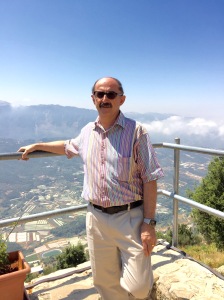 Despite war and the revilement’s of the ravaging that has gone on in Lebanon and the entire Middle East region, hope is strong and the pleasant approach to media downright refreshing. With all of the problems that conflict can bring to a country and its people, Lebanon has had a renewed spirit and strength when it comes to magazine media and media in general.
Despite war and the revilement’s of the ravaging that has gone on in Lebanon and the entire Middle East region, hope is strong and the pleasant approach to media downright refreshing. With all of the problems that conflict can bring to a country and its people, Lebanon has had a renewed spirit and strength when it comes to magazine media and media in general. Ibrahim’s magazine media approach and the mission of his magazine, which seeks to promote the positive and facilitate real change within the Arab world, reminded me of a very famous adage that I use quite often in my teachings and in my own publishing philosophy, and which I also have on a plaque in my office: there is always hope. And that dictum carries so much weight not only in the Arab world, but also in our own American media: he who knows the word hope doesn’t recognize the word impossible.
Ibrahim’s magazine media approach and the mission of his magazine, which seeks to promote the positive and facilitate real change within the Arab world, reminded me of a very famous adage that I use quite often in my teachings and in my own publishing philosophy, and which I also have on a plaque in my office: there is always hope. And that dictum carries so much weight not only in the Arab world, but also in our own American media: he who knows the word hope doesn’t recognize the word impossible.  Since my ancestors, the Phoenicians, created the alphabet; what if there were never any alphabet, the ABC’s you learned in school? You wouldn’t have been able to read this book today! This is the story of the birth of the alphabet, the story of a magical link between a sound and a sign. (From the Little Book of the Phoenician Alphabet)
Since my ancestors, the Phoenicians, created the alphabet; what if there were never any alphabet, the ABC’s you learned in school? You wouldn’t have been able to read this book today! This is the story of the birth of the alphabet, the story of a magical link between a sound and a sign. (From the Little Book of the Phoenician Alphabet)This magazine serves to inspire and document the people, places, organizations, companies, and lifestyle choices that represent our collective desire to meet life head-on with undeniable passion. I hope its pages further inspire you to be Out Living It.



